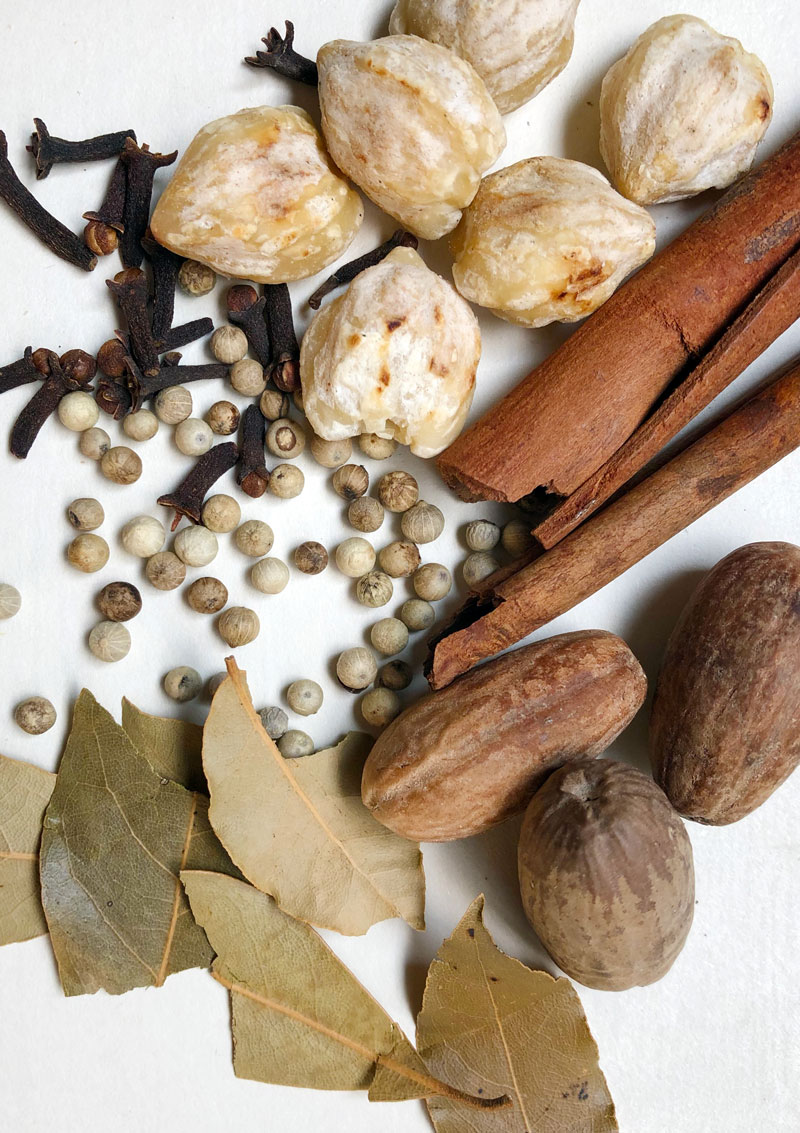
Here’s a list of common Indonesian herbs, spices and seasonings, to give an introduction to Indonesian cooking. We’ve included chilli as well, even though it’s technically a fruit, because what would Indonesian food be without it? And also, staples like sweet soy sauce (kicap manis) and shrimp paste (terasi), because these are crucial to many Indonesian dishes. The list is in English, Indonesian and also in Malay, for readers in Singapore/Malaysia.
Banana leaves (Indonesian/Malay: daun pisang) – used to wrap food, such as meats or rice, to form a parcel that will later be grilled/steamed.
Candlenut (Indonesian: kemiri, Malay: buah keras) – the nut of the candlenut tree, often used in stews. Cannot be consumed raw, needs to either be roasted or blended/pounded and cooked. Adds creaminess to a dish.
Cardamom (Indonesian: kapulaga, Malay: buah pelaga) – cardamom pods are sometimes used to flavour soups and stews, and also in desserts and drinks.
Celery (Indonesian: seledri, Malay: daun sup) – the leaves are often used as a garnish for soups, and sometimes in fried flour-based snacks.
Cinnamon (Indonesian/Malay: kayu manis) – cinnamon sticks are sometimes used to flavour soups and stews, and also in desserts and drinks.
Chilies (Indonesian: cabe, Malay: chilli) – not exactly a herb or a spice, but one of the most important ingredients in Indonesian cooking. Chilli sauces (sambals) accompany almost every meal. A variety of chillies is used, from bird’s eye chillies to green chillies.
Cloves (Indonesian/Malay: cengkeh) – often used in desserts and drinks, and chewed on as a mouth freshener.
Coriander (Indonesian/Malay: ketumbar) – both the seeds and the leaves are used. The seeds are often roasted, then ground/pounded and added to spice pastes, where the leaves are used in cooking or as a garnish.
Galangal (Indonesian/Malay: lengkuas) – a rhizome with pink skin and a white/whitish-pink interior, with a fresh flavour. Often used in spice pastes, and in soups/stews.
Garlic (Indonesian/Malay: bawang putih) – like most other cuisines in the world…..
Ginger (Indonesian: jahe, Malay: halia) – common to Indonesian cooking, like most other Asian cuisines. In Indonesia, ginger is also often used in drinks, such as hot ginger water, and black coffee with ginger.
Indonesian basil (Indonesian/Malay: kemangi) – the leaves of the lemon basil plant, and is the only basil used in Indonesia. Differs from other Southeast Asian basil, such as Thai basil, but Thai basil can be used if unavailable.
Indonesian bay leaves (Indonesian/Malay: daun salam) – used whole, in Indonesian and Malay cooking, to add depth to flavour. If unavailable, can be replaced with Indian bay leaves, sold dried at Indian grocery stores.
Keluwak fruit (Indonesian/Peranakan Malay: keluwak, keluak, Malay: kepayang) – A poisonous fruit that has to be well-treated before it can be cooked. Commonly used in Indonesian and Peranakan Chinese cooking. A distinct taste, colours a dish a deep black.
Lemongrass (Indonesian: sereh, Malay: serai) – the stalks of the lemongrass plant, sliced, with the butt pounded/crushed. Also common in Thai cooking.
Lesser galangal (Indonesian: kencur, Malay: cekur) – a rhizome in the ginger family, with a strong and distinct flavour, adding depth to soups.
Lesser ginger, or fingerroot (Indonesian/Malay: temu kunci, Thai: krachai) – a rhizome in the ginger family, used frequently in Javanese cooking. Also common in Thai cooking, and can be bought in Thai supermarkets under its Thai name, krachai.
Lime leaves (Indonesian: daun jeruk, Malay: daun limau) – the leaves of the lime plants, most commonly kaffir lime leaves. Stalks removed, and leaves torn and shredded to release the fragrance, adding a fresh aroma to the dish. Also common in Thai cooking.
Nutmeg (Indonesian: biji pala, Malay: buah pala) – nutmeg seed, used in rich and savoury stews and soups. Sometimes used whole, otherwise, ground/pounded into a powder, for a sweet and spicy flavour.
Oyster sauce (Indonesian: saus tiram, Malay: sos tiram) – sometimes used a flavour enhancer, especially in dishes with Chinese influence.
Palm sugar (Indonesian: gula jawa, Malay: gula melaka) – a sugar made from the sap of coconut trees, often sold in a packet as a brown, rock-like solid mass, from which a portion is grated and used each time. A rich, unique flavour, used very often in desserts, and sometimes in savoury dishes.
Pandan leaves (Indonesian/Malay: daun pandan) – the leaves of the pandan plant, tied in a bunch and added to savoury dishes, or used as a flavouring in cakes and desserts, for its unique fragrance.
Shallots (Indonesian: bawang merah, Malay: bawang kecil) – shallots, rather than onions, are used in almost every savoury Indonesian dish. They are usually sliced or pounded/blended with other spices to form a paste. Deep fried shallots are used to garnish almost every savoury dish.
Shrimp paste (Indonesian: terasi, Malay: belacan) – a paste made of fermented shrimp, used in many Indonesian dishes, such as sambals, gravies and stews. Often roasted before use.
Spring onions (Indonesian/Malay: daun bawang) – used most often as a garnish, but sometimes in deep fried snacks as well.
Sweet soy sauce (Indonesian/Malay: kicap manis) – with a slightly different flavour compared to Chinese sweet soy sauce, which can be used as a replacement. Used in sambals, sauces, soups and stews.
Tamarind (Indonesian/Malay: asam, asam jawa) – the fruit of the tamarind tree. Often made into a pulp and packaged, and can last a year at least. Often used in stews and soups. Sour, slightly acidic, and gives a refreshing taste. Also commonly used in South Indian cooking.
Turmeric (Indonesian/Malay: kunyit) – the roots of the turmeric plant, and is a rhizome of the family. Most often used freshly pounded or blended in Indonesian, with the skin removed, but dried packaged turmeric powder can also be used.
Turmeric leaves (Indonesian/Malay: daun kunyit) – the leaves of the turmeric plant are also used, as a flavour-enhancer and to add fragrance to a dish.
White pepper (Indonesian: merica, Malay: lada putih) – the powdered form is often, but not always, used as a seasoning.